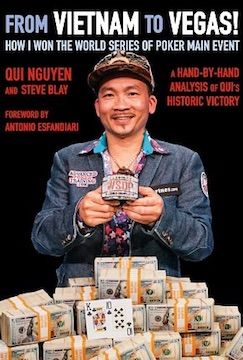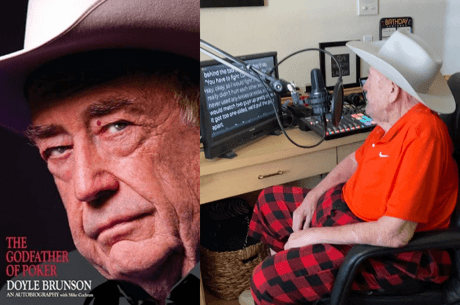PokerNews Book Review: 'From Vietnam to Vegas' by Qui Nguyen and Steve Blay

Every World Series of Poker Main Event final table produces many memorable characters and stories, with the comprehensive blow-by-blow coverage on television and online giving poker players and fans much to consider when parsing through the decisions made and strategies followed by players in poker's most prestigious event.
From Vietnam to Vegas: How I Won the World Series of Poker Main Event, the latest title from D&B Poker, is an enjoyable and enlightening example of such study, in this case delivered from the perspective of the winner, 2016 WSOP Main Event Champion Qui Nguyen.
Writing in collaboration with Steve Blay, Nguyen's book not only chronicles that year's exciting final table in great detail, but provides readers much that is useful regarding tournament strategy, particularly when it comes to the final table and short-handed and heads-up play.
From Simulations to Reality
The story of how From Vietnam to Vegas came to be is an interesting one, one in which PokerNews in fact played a role.
During the interim between the pausing of play in July and the 2016 "November Nine", Steve Blay's training site Advanced Poker Training developed artificial intelligence "bots" with characteristics based on the nine final table participants, then ran 100 simulations of the final table as a kind of preview for how things might play out.
As it happened, APT's sims resulted in Nguyen (second in chips entering that final table) coming out on top the most times of any of the nine players. The study and results were shared here on PokerNews in a series of articles by Marty Derbyshire leading up to the final table �� see "Simulating The November Nine Recap: Predicting a 2016 WSOP Main Event Winner" for an overview of the series and links to each of the entries.
Blay explains in the introduction how Nguyen's family saw those articles, which led Nguyen to contact Blay and invite him to attend the final table. Along with poker pro Young Phan, Blay helped as an advisor to Nguyen during those three days and nights at the Rio All-Suite Hotel & Casino. A couple of weeks later came the idea to continue the partnership and collaborate on a book chronicling the final table, with work beginning shortly thereafter.
Speaking to the authors about the process of writing From Vietnam to Vegas, Nguyen recalls the process of writing the book fondly.
"For me, it was exciting to write the book," explains the Main Event winner. "It took me back to those three days and allowed me to relive it all which was a lot of fun."
Blay fills in further details of their many meetings and phone calls as they gradually worked their way back through the final table. It was a painstaking process, although fun for Blay as well �� and greatly aided by Nguyen's especially thorough memory of the hands and situations.
"He knew every detail of every hand like it had just happened that day," explains Blay. "It was just uncanny �� I didn't have to prompt him at all... even down to what he was feeling at that moment and why he made a particular play."
Intuition Meets Logic on Poker's Biggest Stage
Following a foreword by Antonio Esfandiari (who commentated on the final table for ESPN) and an introduction and initial chapter from Blay, the book shares in-depth analyses from Nguyen of more than half of the 364 hands played at the final table, divided into one chapter each for the three days of play.
Each of the three days helpfully ends with a list of "takeaways" summing up ideas and concepts covered during the hand analyses. Also included is a series of "Q&A" sessions with Nguyen following each day of play, a short autobiography from the champion, and a final appendix from Blay discussing the independent chip model.

In both the introduction and first chapter, Blay points out how Nguyen's style as demonstrated at the final table successfully combines both "poker instinct" and "thought process." That is to say, while making decisions in a given hand, Nguyen is guided both by intuition and logic, as shown repeatedly in the explanations of each hand. Blay notes how "some people might view Qui as a wild gambler, but even though he is not trained in poker math, his decisions made great sense when viewed from a math perspective."
Very soon into the hand discussions it becomes clear how Nguyen's final table strategy was indeed underpinned by sound fundamentals, and that the occasional unorthodox-seeming play was in fact nearly always supported by contextual factors, individual player reads, a keen awareness of stack sizes and/or payouts, and other considerations not always obvious to those watching a live stream.
Every few hands "Steve's Analysis" is additionally included, ranging from a sentence or two to longer discussions of concepts highlighted by the preceding hand. Many of these analyses include hand range charts generated from a tool created by Blay for Advanced Poker Training to help the reader visualize the kind of at-the-table range narrowing in which Nguyen engaged.
The back-and-forth between Nguyen and Blay often tends to underscore the "intution vs. logic" contrast with which the book opens, particularly in those hands where Nguyen's "feel" for a particular situation dictated his action more directly than did the "math."
Hand #109 is a fun one in this regard, one that arose during four-handed play on Day 2. Gordon Vayo had just taken the chip lead, and after he opened from the button Nguyen called from the small blind with 4?4?. Cliff Josephy squeezed with a reraise from the big blind, getting Vayo to fold. Nguyen then reraised all in, getting Josephy to fold A?Q?.

Nguyen explains his read of Josephy and the situation, noting how "I looked at Cliff, and I was quite sure that he was not acting" when making a three-bet that made Nguyen "think he was trying to get rid of us." Blay then comments afterwards how his own math-based background doesn't necessarily help him explain the "read" or the play, forcing him to conclude that "you better know your poker math, but you also need to be able to 'let go' in certain situations and trust your instincts."
Reading through the hands sequentially helps explain what might seem otherwise to be curious or non-"standard" decisions by Nguyen.
In tournaments and especially at final tables, context matters a lot, with what happened in previous hands or even the day before often affecting what might be the recommended play. Nguyen persuasively describes his efforts now and then "to inject some confusion" in the thought process of his opponents by making an unexpected play �� something Blay dubs "judgment jamming." (Knowing all hands would be shown a half-hour later further helped Nguyen in this regard, as he knew even hands he didn't show would later be seen.)
Nguyen also includes key hands from the final table in which he was not involved, including all of the knockouts. Perhaps the most interesting of these is the hand in which Vojtech Ruzicka lost nearly all of his stack five-handed after triple-barreling with ace-high (holding ace-king on queen-high board) and losing to Gordon Vayo's flopped set of eights. Both Nguyen and Blay afterwards analyze Ruzicka's situation well, noting both Vayo's relative tightness (making him a less attractive opponent against whom to bluff) and how Ruzicka likely would've earned folds against many other hands.
Perhaps most interesting when reading through the first two days' worth of hands is Nguyen's ongoing gathering of evidence regarding the styles of Vayo and Josephy �� the two players who will ultimately be left with him to comprise the last three players on the tournament's final day.
Nguyen persuasively describes his efforts now and then "to inject some confusion" in the thought process of his opponents by making an unexpected play �� something Blay dubs "judgment jamming."
Even hands that superficially aren't terribly intriguing (e.g., preflop raise-and-takes) help build a larger picture, with Vayo's tendency toward tightness and Josephy's unpredictability becoming increasingly evident to Nguyen as play progresses. Nguyen even begins to consider the possibility that Josephy has picked up a tell on him, further confirming to him that Josephy �� whom he describes as "the most volatile and creative opponent at the table" �� stood to be his greatest worry on the final day.
The final day began with Nguyen the overwhelming chip leader and Josephy the short stack, although Josephy helped his cause from the start with a big double through Nguyen on the first hand of the last day. Unfortunately for Josephy, he was soon after on the wrong side of a set-over-set situation versus Vayo, and a dozen hands later lost the last of his chips to be knocked out in third.
That set up the marathon heads-up between Vayo and Nguyen, lasting 182 hands (in fact, exactly the number it took to play down from nine players to two). Nguyen analyzes many of those hands, showing how he was able to pursue an overall strategy to pick up pots with aggression and remain patient against a solid opponent.
The "Q&A" sessions following each day of play provide further background from Nguyen about the excitement of playing the final table. His short autobiography then relates the story of Nguyen's childhood in post-war Vietnam, a challenging experience that he says helped him later at the poker tables when it came to managing risk and reading others. He tells of moving to the United States in 2001 his early 20s, learning hold'em in Alaska, improving his game in Florida, then eventually moving to Las Vegas where he continued to hone his game.
"A New Manual on Poker"
While reading From Vietnam to Vegas I found myself occasionally thinking back to the experience of reading another, somewhat similar book many years back �� Gus Hansen's Every Hand Revealed (reviewed here almost a decade ago).
Hansen's book also analyzed a number of hands from a single tournament won by the author. Like Hansen often could be seen doing during those earlier years of televised poker, Nguyen employed an aggressive, sometimes unorthodox style at the 2016 WSOP Main Event final table that occasionally confounded observers at first blush.
"I could not figure out Qui Nguyen if my life depended on it," said Esfandiari in his commentary (a quote the book includes early on). "We're going to have to get a new manual on poker... I can't wait to read his book."
From Vietnam to Vegas indeed helps explain all of Nguyen's bold bets and bluffs, curious calls, and fantastic folds. But like Hansen's book it also provides genuine insight into how both intuition and logic work together to form a winning tournament strategy.
From Vietnam to Vegas: How I Won the World Series of Poker Main Event by Qui Nguyen and Steve Blay is available in both paperback and ebook versions via Amazon or directly from D&B Poker.









